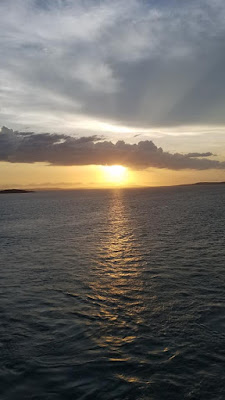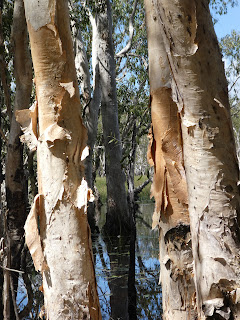About a week ago, Cyclone Veronica hit land to the south of Broome. Our Captain had mentioned that he diverted the ship around the residual effects of the storm as we headed up the coast. We are thankful we missed the cyclone.
Our plan for the day is to buy tickets for the Hop On Hop Off bus and check out what's in Broome.
We hop off at our first stop to check out Cable Beach.
This is Cable Beach...13 miles of sparkling blue water and white sand.
The beach is washed clean every day by the massive tides.Cable Beach offers camel rides for visitors. Having ridden camels recently in both Egypt and Morocco, it was not a must-do for us. Some people are out there on camels, though.
It was great to see this beach. But WOW is it HOT and very HUMID. We don't last long standing out in the sun.
Broome didn't get established until 1861 when the discovery of pearl oysters drew thousands of people from around the world to go pearling. This is the Pearl Luggers Museum. The divers harvesting the oysters are called luggers.
We walked around the outside exhibits to learn a little about the pearl luggers.
The lugger boat used to harvest the oysters from deep in the ocean.
The first luggers were aborgines who would free dive down to pick the oysters. Then came the invention of the helmet for diving.
It was heavy and cumbersome.
The Japanese seemed to be the best divers.
From the museum display, here's photo of a tender...usually a young boy who held the air hose for the diver. He literally held the diver's life in his hands.The inside of an oyster's shell is covered with a smooth, shiny coating called mother-of-pearl. When an irritant, such as a grain of sand, gets caught inside the oyster's shell, it secretes layers of mother-of-pearl to protect its body by coating the irritant. This is the birth of a pearl. The first use of the mother-of-pearl was for buttons. It is said that "Broome was built on Buttons!"
Pearling was a dangerous profession and many luggers died as a result of diving accidents or the bends. We stopped by the Japanese Cemetery where 909, mostly luggers, are buried.
A gravestone in the Japanese cemetery.
We saw lots of "bottle trees" as we rode the HOHO bus around Broome.
So what better way to spend the afternoon than reading on the deck.
The next day was a sea day for us, which included a scenic coastal cruise along the Kimberly Coast and ended with a beautiful sunset.
In the afternoon we started to see a few islands, or islets as these are called.
People are out on the decks for a great view.
Then we pass the sunlit coastline filled with cliffs.
We patiently wait...
Going, going...
Just about gone.
The Northern Territory is the most commonly mentioned potential seventh state of Australia. But it is not a state. In 1998, the voters of the Northern Territory rejected a statehood proposal that would give them 3 senators rather than the 12 held by the other states. The voters didn't like that and it remains a territory instead of a state.
The morning started with a beautiful sunrise as we neared the port.
When the HMS Beagle sailed into the bay in the 1860s, the captain named the harbor area Port Darwin after his good friend and sailing mate, Charles Darwin, the well-known evolutionist.
I booked a tour with Ethical Adventures, a tour company that would take us to Litchfield National Park where we could see termite mounds, waterfalls, and a chance to cool off in the water. It is very HOT here at the top of Australia.
We have a large van for 8 people; much better than a big bus from a ship's tour. We head to Litchfield National Park, about an hours' drive from Darwin.
Our first stop in the park was at a Cathedral Termite mound. It takes the termites 7 years to build up just one foot in height.
This is a Magnetic Termite Mound. Up to 100 years old, these structures are unique to the northern parts of Australia.
The mound's edges point north and south and the flat backs east west, similar to a magnetic compass. This minimizes the mound's exposure to the sun, keeping the mounds cool for the magnetic termites inside
We walked to an overview of Tolmer Falls hidden away in a narrow gorge.
It plunges 335 feet to the pool below.
Then we stopped by Table Top Swamp, headwaters for the rivers that go to the falls
We called this Monet's Waterlilies of Australia.
We walked on a trail to Florence Falls.
It is a multi-tiered series of falls.
People were swimming under the falls here. It is a crocodile-free swimming hole. Yes, many of the rivers are home to crocs.
We had hoped to swim here but it would take too much time of our limited time for the tour.
Here we are with our traveling friends, Jerry and Gwen at the viewing point above the falls.
We do have a the opportunity to take a quick swim in Buley Rockhole where we stopped for lunch.
Terry is in the water...
I'm in the water...
And I take off over the cascade, taking photos as I float.Back on the ship we bid farewell to Darwin. The buildings are all fairly new as what wasn't destroyed during bombings in WWII, Cyclone Tracy destroyed what was left in 1974.
And sail towards our next port, Cairns and the Great Barrier Reef.
The next port, Cairns, is a tropical city at the top of Australia. It dates back to 1876 when it originally served as a port for shipping gold and tin. Today it is a great tourist destination because of the Great Barrier Reef just off its shores.
This is what greeted us as we arrived in port..RAIN! April is at the end of the "wet season" and the area is home to one of the world's most ancient rainforests...so we weren't surprised but hopeful it would not stop our plans for the afternoon.
I booked this company online; they picked us up at a hotel a short distance from our cruise ship and brought us to the airport. It was raining at the airport. We had to wait a little while for the weather to improve for our take off.
Here's our pilot going over a few safety issues before we board the plane.
Ready for take off...And we are, too!
We take off in a 6-passenger plane for an hour's ride over the GBR. Our pilot said the reef was clear.
And he was right. Here's a sampling of what we saw...
This is Green Island in the world's largest reef system that stretches over 1,250 miles along Australia's coast.
There are about 3,000 reefs
And 2 000 islands
We head back to the shoreline north of Cairns
And follow the coastline along the rainforest back to Cairns.
Back in rainy Cairns, here we are with our pilot Josh.
And here's the plane we rode in. Great fun and we were sure lucky with the weather.
When we were able to stay several days in the Cairns area in 2010, we experienced a lot more of the area. To read about our previous Cairns adventure, click here.
We now head to New Guinea, a new country for us. Scroll down and click on "Newer Post".











































































No comments:
Post a Comment